Indian Train
This is for those of you who are new to India, and also new to the train travel in India in particular.
H
ere you are going to get a flavor of the Indian Railway system and tips on how to plan your train journey in India. Also we’ll try to understand a bit about various classes of the trains ; their pros and cons.This is going to be a bit long, like a train journey. What you need now is bit of patience and a big mug of beer!
If you are looking for schedules/travel plan see a comprehensive Railway Time Table list here, otherwise go ahead and read further.
Let’s start without wasting any more time. At first we’ll try to get a grip on the classes you can opt for in a typical long-distance train.
Second Class ( General Compartment) :
This is the lowest cost means of travel imaginable to travel across India (baring the “ticketless class” of course! ) . No advance reservation. Buy the ticket directly from the railway station counter. Stand in that long queue, otherwise elbow through that bee’s nest around the counter (your experience in rugby goes a long way in getting a ticket from a crowded counter!) . Now you have got a ticket, means you have won half the war. Let’s head towards the train to capture a seat. Like mentioned earlier there would be no seat number mentioned on your ticket. Seats are ‘captured’ on a first come first served basis. Typically the window seats are filled first. Tickets are issued on demand, means the coaches can get overcrowded during the peak seasons and also in the busy routes. And that earned in the nickname - “The Cattle Class”!
Indian Train : Second class seats
Nevertheless the second class is very much an option to travel through India. Facilities and comforts are bare minimum. Seats are generally in the form of wooden benches, new coaches now a days come with the cushions though. Two sets of toilets are attached at the either ends of the coach. Typically they are of the typical Indian style (squat type) ones, more on the train toilets later.
Usually the general coaches are attached at the ends of the train (2 + 2 coaches). Compartments are fan cooled. The ambient is noisy and not known for great privacy. Carry a small chain and a padlock to secure your backpack under your seat or on the luggage rack. This is highly desirable if you are on a long journey.
Okay, enough of cynicism on the second class coaches. What are the positives? The most attractive is its fare structure. The longer you travel the fare rates are lower. A second class ticket costs just Rs350 (USD 9) for the two day-two night long journey from New Delhi to Trivandrum in Kerala ( a distance of 3000 kilometers/1860 miles ) . For the same journey in the Second Class AC coach by the same train cost you about Rs 2300 (USD 56) . That’s just for a comparison.
If you belongs to the genre of tourists that’s all out to experience the so called ‘real India’ travel by the second class, at least once.
Sleeper Class ( SL )
The Sleeper Class constitutes the bulk of a typical express train. About a dozen of the sleeper coaches are attached to important long distance trains.
You need to reserve a seat in advance to travel by the Sleeper Class. Details on how to reserve your seat/berth is explained in the in Advance Reservation.
Each Sleeper Class coaches contain 72 seats and berths. Reservation for seats and berths are done together by default. In other words, you don’t have to book seats are berths separately.
Sleeper coach contains rows of semiprivate bays of berths. Each bay contains 6 berths (6 seats). That is two rows of 3 seats each facing each other - a side seat, a middle seat and a window seat.
Window view from Second Class Sleeper coaches
The upper berth is reserved for the side seat passenger; lower berth belongs to the window seat and the middle seat for the middle berth. The lower berth actually acts as a row of 3 seats for the day time. The middle berth is kept folded during the day and the upper berth is undisturbed during the day. That means the upper berth can be used by the passenger even during the daytime.
So decide your preference first and opt for the choice when you reserve the berth. Consider a few more points in deciding the berth. During the night , the upper berths are relatively more private. Also the noise is much less on upper berths compared to the lower berth, especially when your berth comes just above the wheels. The next advantage of the upper berth is that you can take a nap whenever you feel like, especially during the day time. The plus side of the lower berth is that it comes with the window seat. So during the day time the window seat is more secluded and obviously a first choice to enjoy the outside views.
Apart from the above sets of 6-berth bays, there are rows of single seats with berths on the other side of the aisle. These seats are paired -2 single seats facing each other . The only shortfall of these seats are the shorter length of its berths. If you are very tall, it is a bit difficult to sleep straight on these side berths. Opt for Side Upper (SU) are Side Lower (SL) berths, if you prefer these seats.
When you reserve a seat mark your berth preference - Lower, Middle or Upper. If your choice is available, it will be allocated otherwise it will automatically select the next berth available. When you reserve over the reservation counter you can as for your second choice of berth however.
Side seat ( a.k.a bay seats) in Second Class Sleeper coaches
Inside the train you can request your co passengers for a possible exchange of the berths. You can see the younger passengers exchange their lower berths with senior passengers with upper berths allocated.
The coaches are fan cooled. No bedrolls are supplied. Carry a set of bed sheets and a pillow ( air pillow). Two toilets each are attached at the either ends of the coach , just next to the doors. One of the four is usually of the western style and the rest are of Indian (squat) type . Water taps are provided inside the toilet. Bring your own toilet paper roll.
The sleeper coaches are marked as S1, S2 , S3 ….etc. Your coach number is marked accordingly in the ticket. When you arrive at a station, enquire with the station staff for the position of the coach. That way you can avoid the last minute hurry when the train arrives. Your name appears in the chart stuck next to the entrance of your coach.
AC 3 Tier ( 3A )
AC three tier is the lowest cost class in the AC sleeper classes. The coach layout appears more or less similar to the Sleeper Class, though a bit spacious. Each 3A coaches accommodate 64 passengers. A typical long distance train is attached with 2 or 4 3A coaches.
Thanks to its attractive fare structure compared to the other higher class fares, 3A seats always get booked fast. The wait list of 3A too doesn’t advance faster (like in case of Sleeper Class) , as there are only limited seats available per train .
The coaches are fixed with non-openable tinted glass windows. That means you can’t enjoy the scenery outside, the way it is possible the more open and airy Sleeper Class. Also it restricts the ‘window sale’ of food and drinks available at stations, the part and parcel of rail travel in India. More of it is explained in the Food in Trains.
Bedroll is provided inside the coach (a thin pillow, 2 white linen sheets and a woolen blanket) . Your 3A ticket comes with a free luggage allowance limit of 40kg ( plus 10kg marginal allowance) . Officially the size of the luggage pieces allowed inside the 3A coaches is 55cm x 45 cm x 22.5 cm . However this is not as firmly insisted as in the case of airlines.
Reservation Chart : The chart is stuck next to the door. A copy is avaiable with the Traveling Ticket Examiner (TTE) too.
AC Two tier
First class AC
First class
AC chair car
Executive class chair car
Break Van
Toilets
Toilets are located at the extreme ends of the coaches. Each coaches are attached with four toilets. One of it is of the western style, while the other three are of the Indian type (squat toilets).
A little preparation and a bit of courage is required to use the toilets in a running train. And to make things harder, railways advice passengers not to use the toilets while the train is stopped at stations!
The handle bar provided next to the water closet is a helpful provision. A water tap is attached in the train toilet, similar to a typical Indian toilet. But you have to bring a plastic mug to hold water. The mugs are sold by the platform vendors for a few rupees. Bring Your Own Toilet Paper ( BYOTP ! )
A washbasin with a water tap and a mirror is provided at the corner of the toilet. A similar provision is provided just outside to toilet too.
A word of caution, especially while using the Indian type toilet. If anything falls to the toilet floor, it is likely that it may slip into the toilet hole. So be careful with things like keys, wallet , spectacles and the likes.
Though not strictly enforced, it is requested by the Railways to avoid using the toilets while the train is at station.
Travel Plans and Train Schedules: Indian railways operates a an overwhelming number of trains everyday. The statistics is bit difficult to comprehend. Baring a few militarily organisations in the world, its work force is is a whooping 1.4 million people. About 5.4 billion trips are made on on its tracks every year. Each day some 12,000 Indian trains ply over 63,000 km of track with covering 7,000 stations. If all those journey distances are added together, Indian trains travel four times the distance to the moon and back everyday! And now think of the number of people it moves every day on the jam packed trains.It's left toy you to imagine.
You can see a comprehensive Railway Time Table list here and also a guide published by Indian Railways called Trains at a Glance describing the schedules and a lot more about the travel plans.
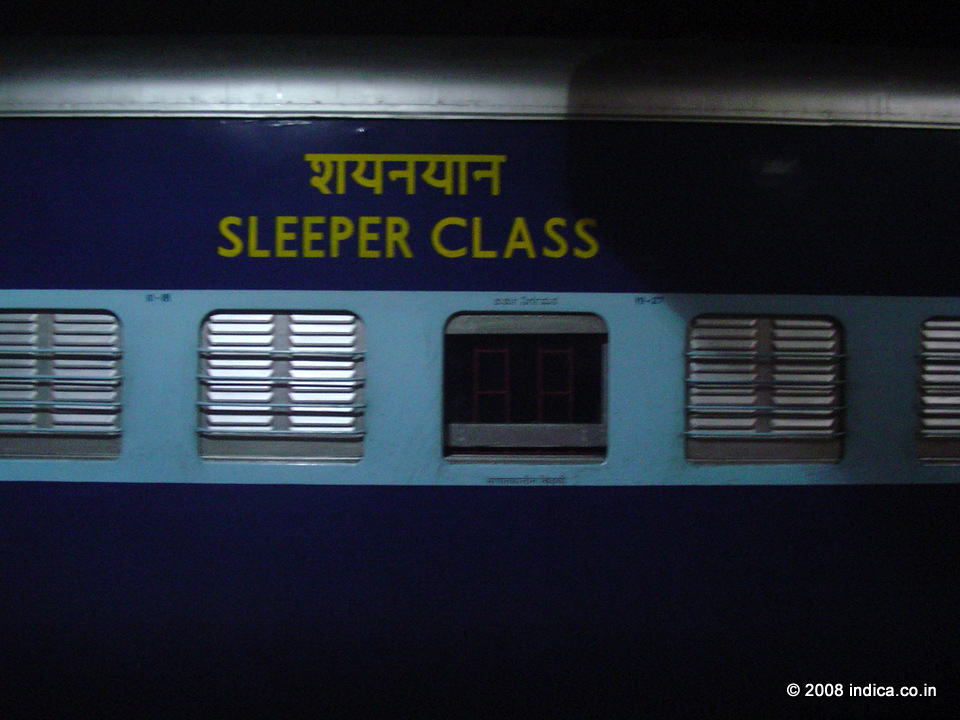
Sleeper Class Coach in Indian Trains
Sleeper Class Coach in Indian Trains
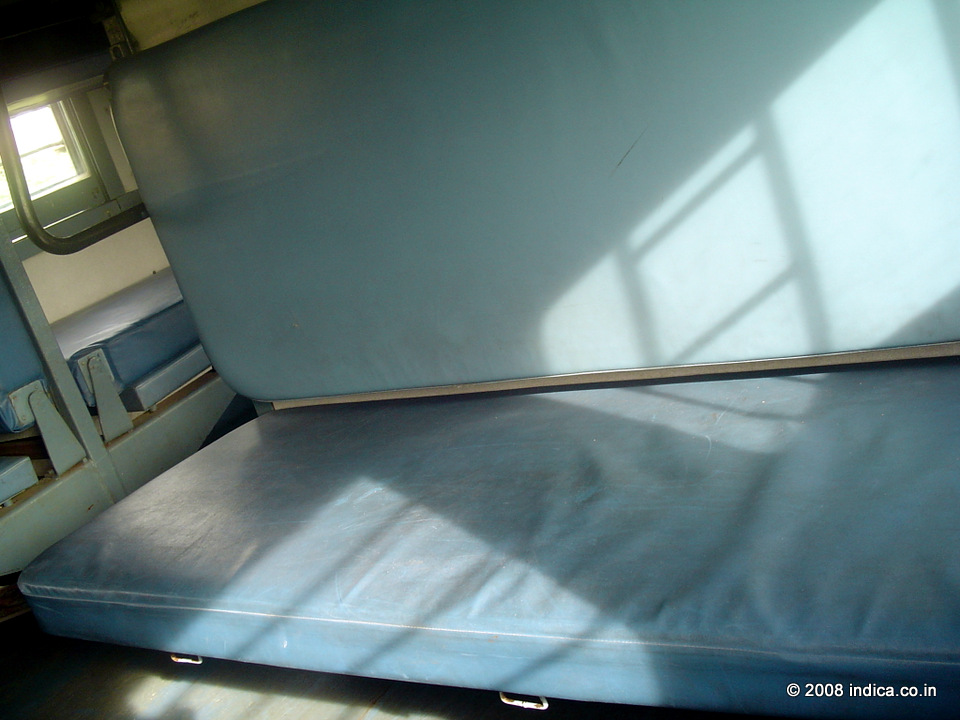
The sleeper class lower berth that duals as the sets during the daytime
The sleeper class lower berth that duals as the sets during the daytime
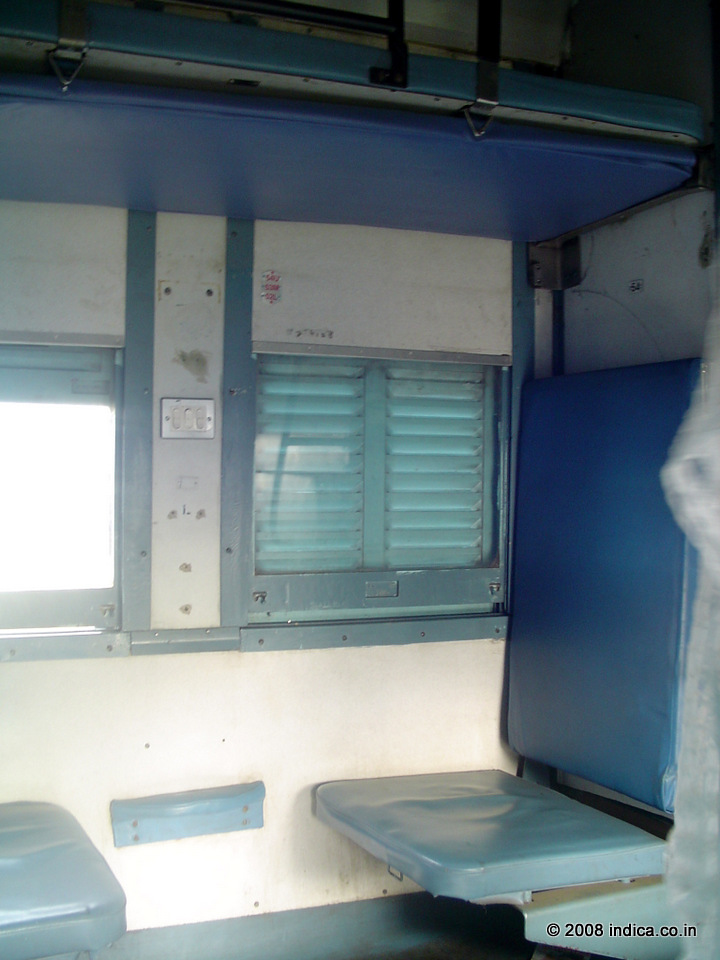
Aisle Seats, a sought after thing during the day time and a pain in the night time, thanks to its cramped size.
Aisle Seats, a sought after thing during the day time and a pain in the night time, thanks to its cramped size.
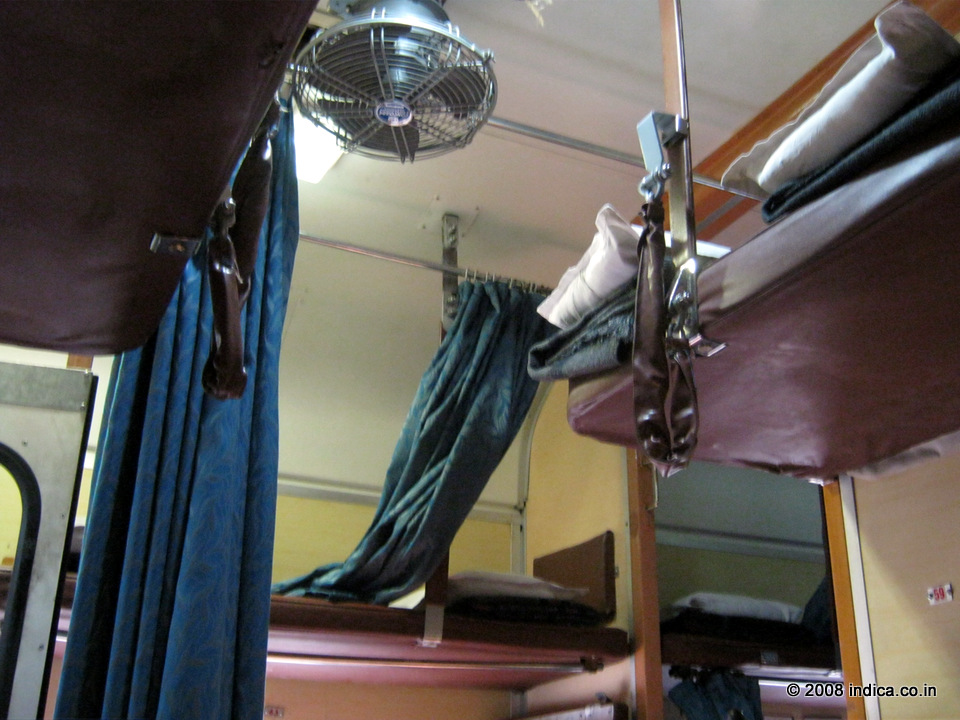
Inside 3 AC Coach
Inside 3 AC Coach in Indian Trains
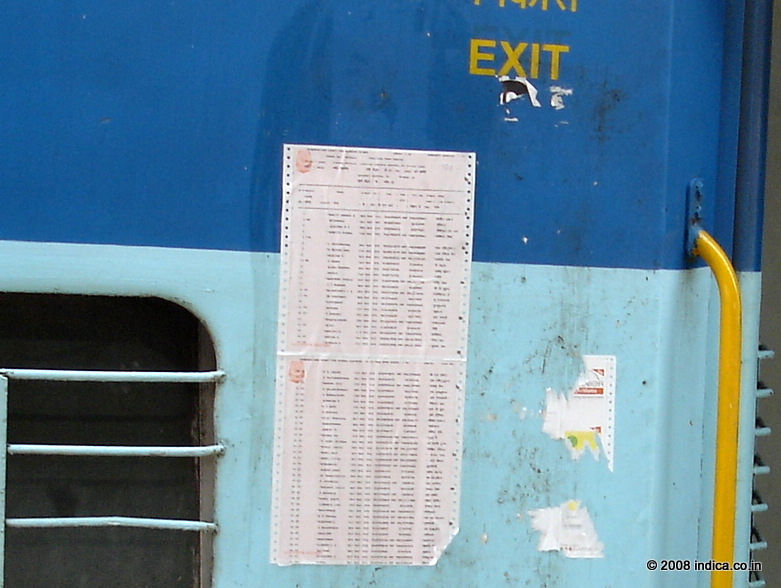
Reservation Chart stuck next to the entry of all reserved coaches.
Reservation Chart stuck next to the entry of all reserved coaches.
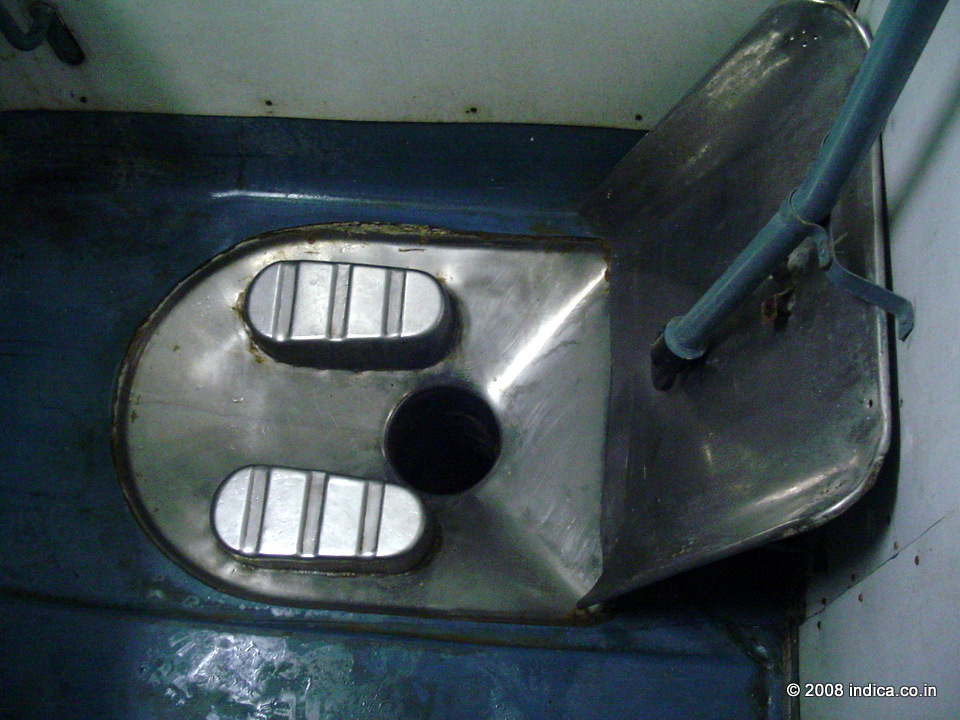
Indian Style toilet in Sleeper Class coaches
Indian Style toilet in Sleeper Class coaches in Indian Trains.
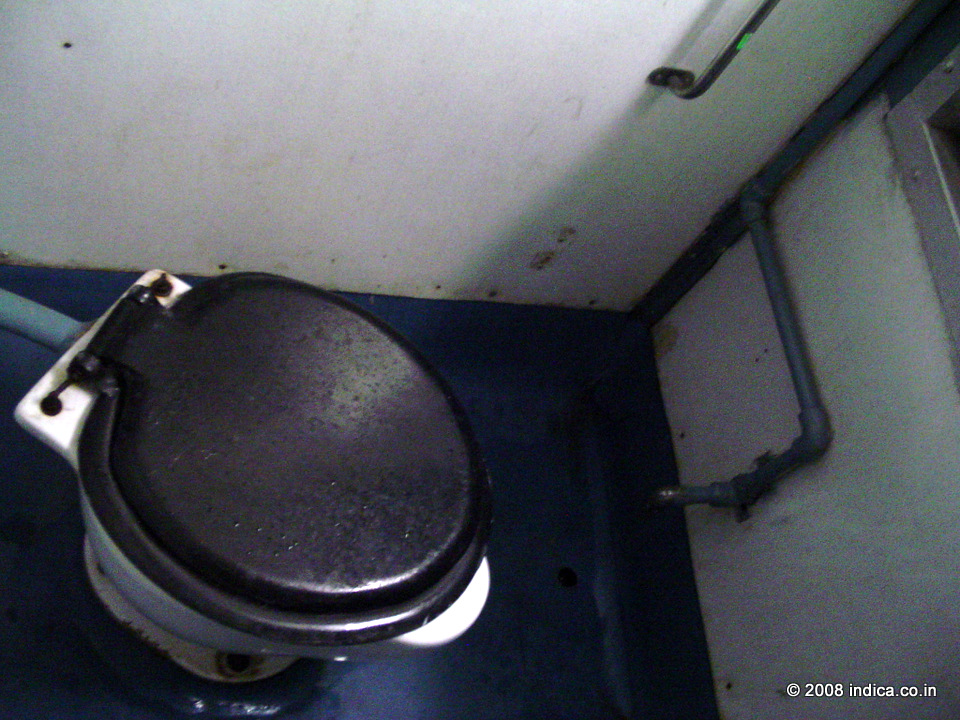
WC toilet in Sleeper Class coaches
WC toilet in Sleeper Class coaches
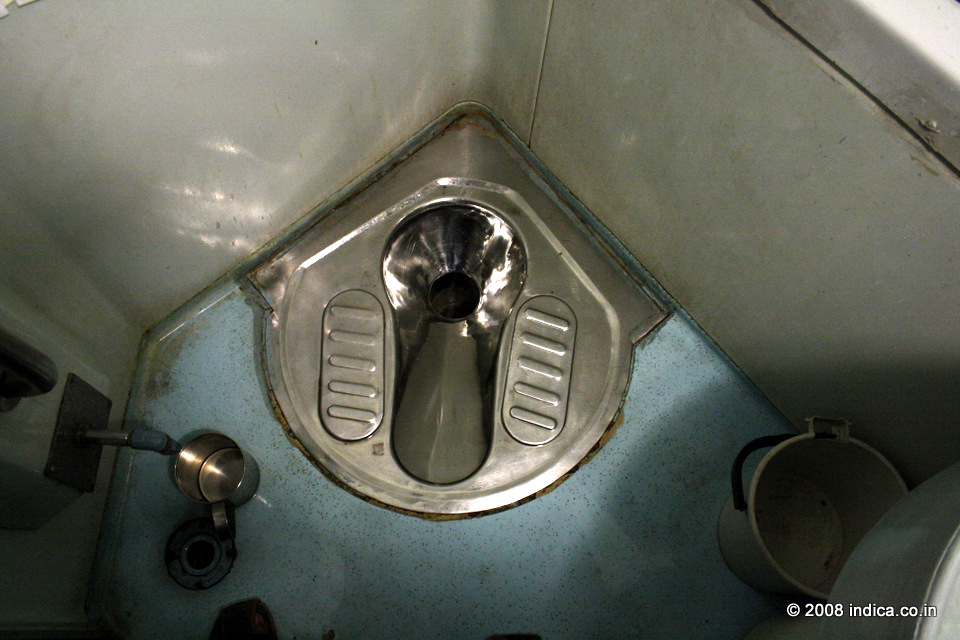
Indian Style toilet in 3 AC coaches
Indian Style toilet in 3 AC coaches in Indian Trains
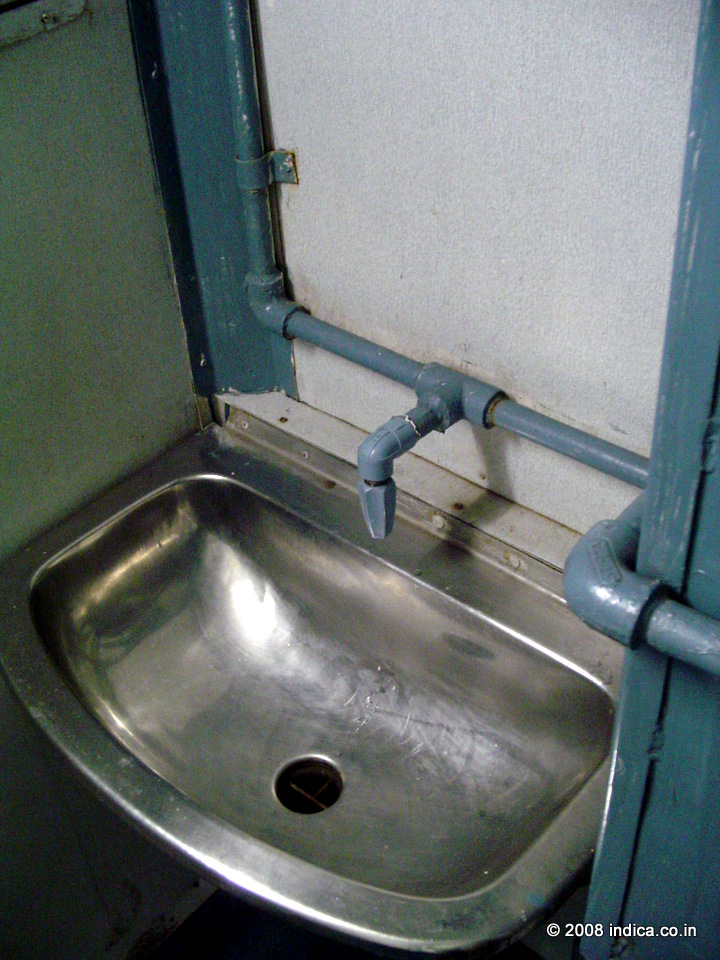
Wash Basin , located next to the doors
Wash Basin , located next to the doors
